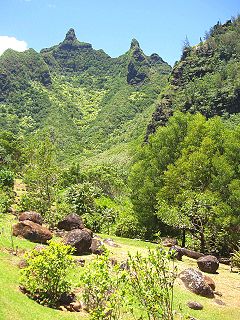
Pinus strobus, commonly called the eastern white pine, northern white pine, white pine, Weymouth pine (British), and soft pine is a large pine native to eastern North America. It occurs from Newfoundland, Canada west through the Great Lakes region to southeastern Manitoba and Minnesota, United States, and south along the Appalachian Mountains and upper Piedmont to northernmost Georgia and perhaps very rarely in some of the higher elevations in northeastern Alabama. It is considered rare in Indiana.

The blue spruce, also commonly known as green spruce, white spruce, Colorado spruce, or Colorado blue spruce, is a species of spruce tree. It is native to North America, and is found in USDA growing zones 1 through 7. It is found naturally in Arizona, Colorado, Idaho, New Mexico, Utah and Wyoming. It has been widely introduced elsewhere and is used as an ornamental tree in many places far beyond its native range. The blue spruce has blue-green colored needles and is a coniferous tree.

A hardiness zone is a geographic area defined as having a certain range of annual minimum temperature, a factor relevant to the survival of many plants. In some systems other statistics are included in the calculations. The original and most widely used system, developed by the United States Department of Agriculture (USDA) as a rough guide for landscaping and gardening, defines 13 zones by long-term average annual extreme minimum temperatures. It has been adapted by and to other countries in various forms.

The Limahuli Garden and Preserve is a botanical garden and nature preserve on the north shore of Kauaʻi island, Hawaiʻi. It is one of the five gardens of the non-profit National Tropical Botanical Garden.

Brighamia insignis, commonly known as ʻŌlulu or Alula in Hawaiian, or colloquially as the vulcan palm or cabbage on a stick, is a endangered species of Hawaiian lobelioid in the bellflower family, Campanulaceae. It is native to the islands of Kauaʻi and Niʻihau. This short-lived perennial species is a member of a unique endemic Hawaiian genus with only one other species.

Bear Creek is a ski resort near the borough of Macungie, Pennsylvania in the Lehigh Valley region of Pennsylvania, in the United States. The resort opened in 1967 and was known as the Doe Mountain until 1999. The official name of the property is Bear Creek Mountain Resort & Conference Center. It is a year-round resort on more than 330 acres (1.3 km2) that features a variety of activities and amenities.

Varronia rupicola, synonym Cordia rupicola, commonly known as the Puerto Rico manjack, is a critically endangered species of flowering shrub in the borage family, Boraginaceae, that is native to the islands of Puerto Rico and Anegada.

Atriplex confertifolia, the shadscale or spiny saltbush, is a species of evergreen shrub in the family Amaranthaceae, which is native to the western United States and northern Mexico.
Hibiscadelphus woodii, or "Wood's hau kuahiwi", is a species of flowering plant in the family Malvaceae, endemic to Kauai, Hawaii. It is a small tree, reaching a height of 2.5–5 m (8.2–16.4 ft).
Kokia kauaiensis, the Kauai treecotton or Kauaʻi Kokiʻo, is a species of flowering plant in the mallow family, Malvaceae, that is endemic to Kauaʻi, Hawaii.

Crataegus succulenta is a species of hawthorn known by the common names fleshy hawthorn, succulent hawthorn, and round-fruited cockspurthorn. It is "the most wide-ranging hawthorn in North America", native to much of southern Canada, and the United States as far south as Arizona, New Mexico, Kansas, Missouri, North Carolina, and Tennessee. In this wide area there are many variant forms that have received species names, but can also be considered as synonyms. It is thought to be the parent, along with Crataegus crus-galli, of the tetraploid species Crataegus persimilis.

Lipochaeta, common name nehe, is a genus of flowering plants in the family Asteraceae that is endemic to Hawaii.

Wilkesia hobdyi, the dwarf iliau, is a species of flowering plant in the family Asteraceae that is endemic to the island of Kauaʻi in Hawaii. It was first collected in 1968, and was not formally described until 1971. The number of living plants is estimated at fewer than 300. It is considered Critically Imperiled in global rank which means it is at very high risk of extinction. It has been a federally protected species since 1992. The genus Wilkesia is one of three genera constituting the silversword alliance, a group of highly diverse yet genetically exceedingly closely related species, all thought to be descended from a colonizing ancestor related to the tarweed of North America.

Wedelia acapulcensis, commonly known as Acapulco wedelia, is a species of flowering plant in the family Asteraceae. It is native to Texas in the United States, Mexico, and Central America.
Melanthera kamolensis, known by the common name Maui nehe, is a rare species of flowering plant in the family Asteraceae.

Lipochaeta lobata is a species of flowering plant in the family Asteraceae known by the common name shrubland nehe. It is endemic to Hawaii, where it can be found in coastal dry shrublands and dry forests on Oʻahu, Maui, and Niʻihau.

Melanthera micrantha, known by the common name Kauai nehe, is a rare species of flowering plant in the family Asteraceae.

Melanthera tenuifolia is a rare species of flowering plant in the family Asteraceae known by the common names Waianae Range nehe and slender-leaf nehe.
Melanthera venosa is a rare species of flowering plant in the family Asteraceae known by the common name spreading nehe. It is endemic to Hawaii, where it is known only from the island of Hawaii. It is federally listed as an endangered species of the United States.
Melanthera waimeaensis is a rare species of flowering plant in the family Asteraceae known by the common name Waimea Canyon nehe. It is endemic to Hawaii, where it is known only from the island of Kauai. It is federally listed as an endangered species of the United States.
















